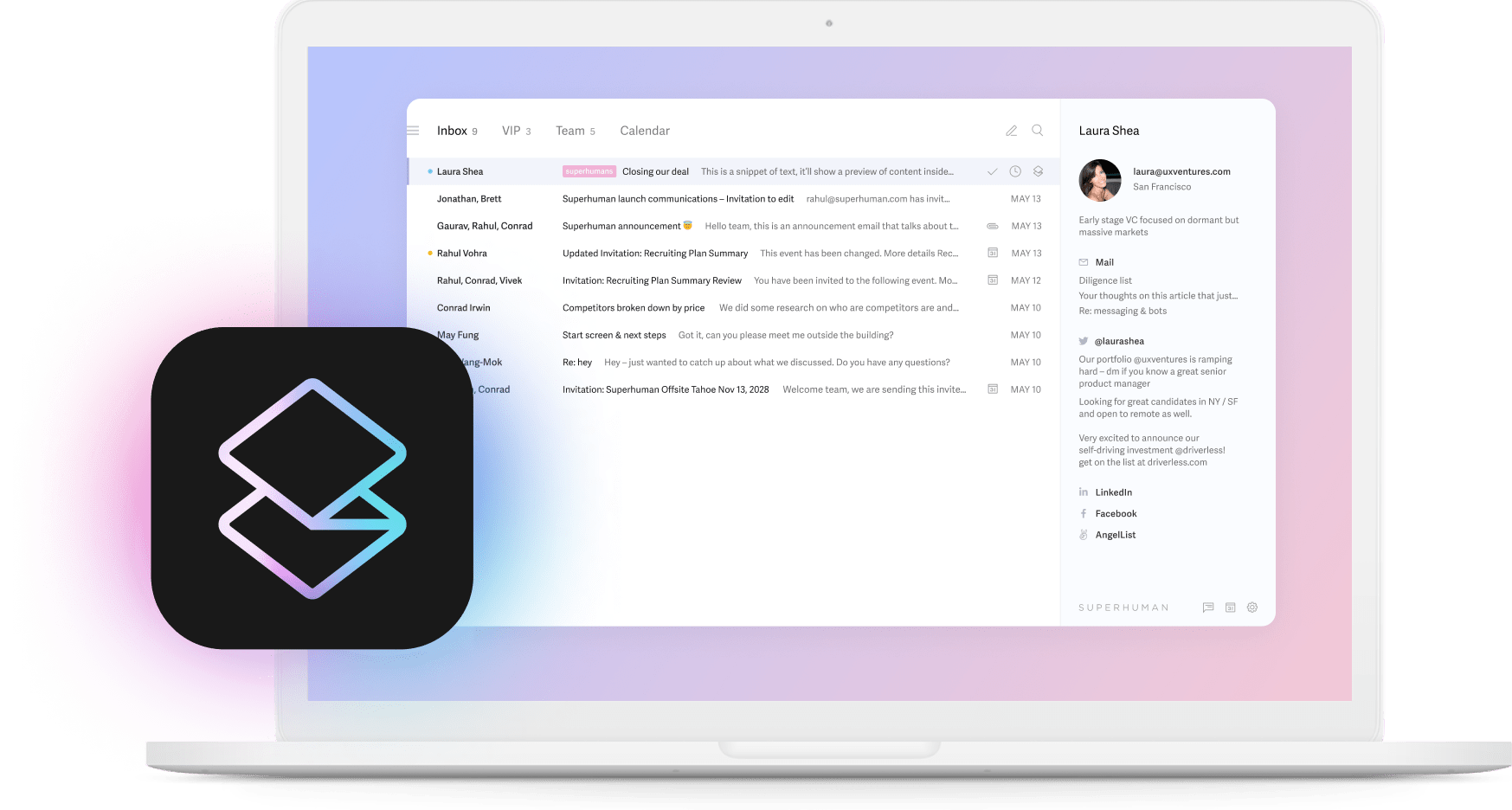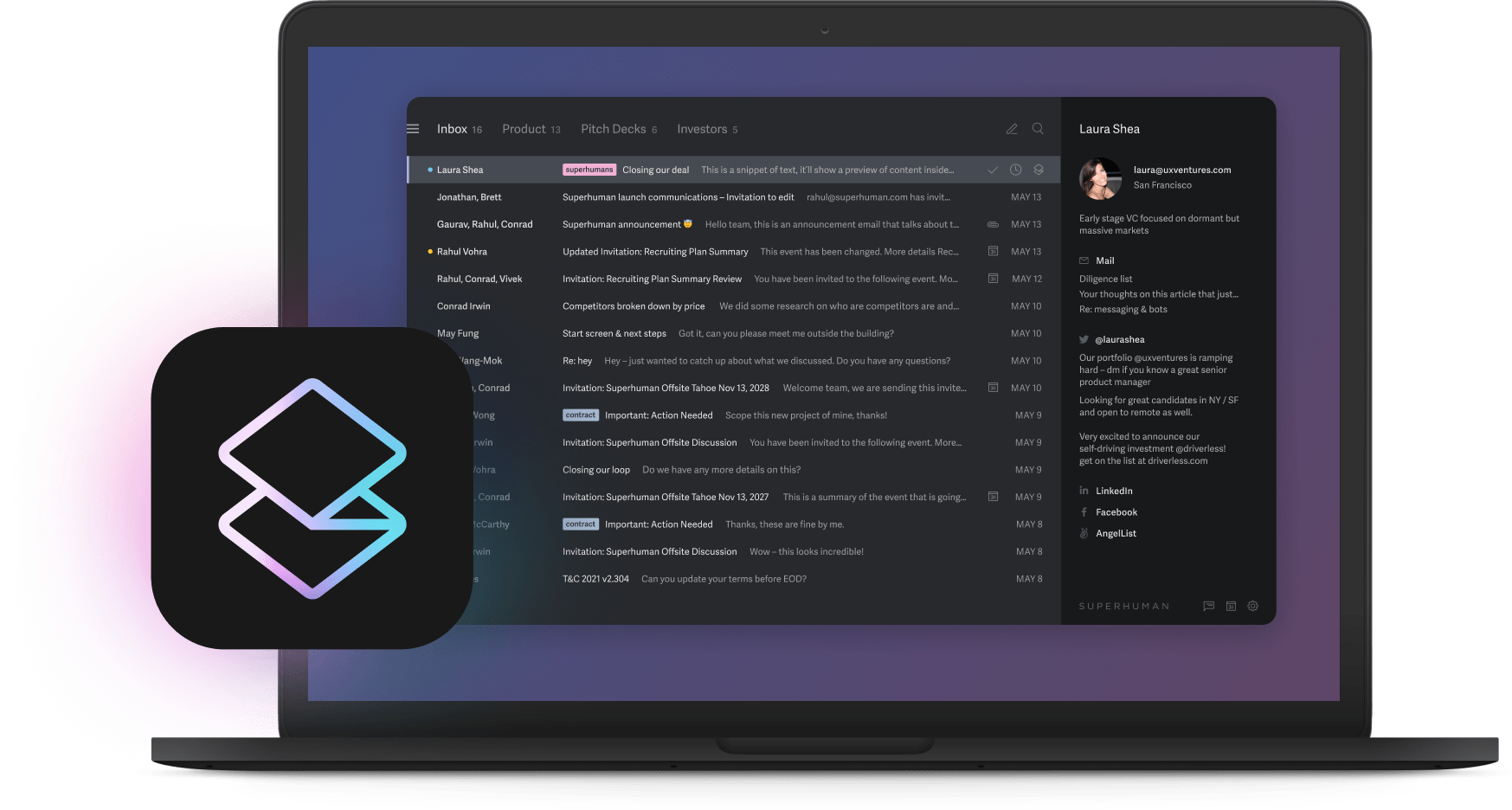
When you send hundreds of emails to potential candidates every week, a recruiting email template is a must. Using a template can help you save time and make more connections — but only if it's an effective template that gets the right kind of attention from candidates.
We'll teach you when and how to use recruiting email templates effectively. Plus, 17 templates to help you stand out in candidates' inboxes.
If you want a proper email format ready for every stage of the recruiting process, this guide is for you. Let's dive right in:
When to use recruiting email templates
There are certain times when it's best to use a template for a recruiting email, including:
- When connecting with a candidate for the first time
- When following up with a candidate who didn't respond
- When sending an interview invitation
- When sending interview confirmations and reminders
- When sending job offers
- When sending rejections
When not to use recruiting email templates
On the other hand, there are also times when a template isn't the best way to go for an email from a recruiter. These include:
- When answering candidate questions
- When doing highly personalized recruiting for a very unique role
17 recruiting email templates that work
First touch sourcing email templates
A first-touch sourcing email is when you're contacting a prospect for the first time. If they're a strong candidate, you won't be the only recruiter in their inbox, so your goal should be to stand out and catch the candidate's attention and interest.
Why it's important: This is your chance to make a first impression with every candidate in your pipeline. First-touch sourcing emails help you build and manage your talent pipeline. They're essential to a recruiter's day-to-day work of maintaining a high-quality pool of applicants with diverse backgrounds and skills. They're essential to your success as a recruiter.
What it should include: Some personal details about the candidate you uncovered during your research, like a mutual connection or a shared interest. If you're reaching out about a specific job, include some basic information about it. End with a CTA clearly defining the next step you want the candidate to take.
Here’s what a first-touch sourcing email should include:
- How you found the candidate (especially if you have a mutual connection)
- One line about the role itself
- Why the candidate would be a good fit
- A CTA outlining what the candidate should do next
Cold recruiting email template
Hi <first-name>,
You probably get this a lot, but I saw your profile on <LinkedIn or other platform> and your background really caught my eye!
I'm filling a role in <job-title> for <your-company-name>. Because of your experience in X, I think you'd be a perfect fit.
If this interests you at all (or you want to talk about other opportunities), let's hop on a call in the next few days! Let me know your availability and I'll send you an invite.
Thanks,
<Signature>
Referred candidate introduction template
Hi <first-name>,
<Contact> at <company> gave me your name and spoke very highly of you. I was particularly impressed with <work experience or personal detail>!
I work for <your-company> and we're looking for someone who would be a great fit for <role>. Based on <contact>'s recommendation, I'd love to speak with you about this!
If this interests you at all (or you want to talk about other opportunities), let's hop on a call in the next few days! Are you available for a quick call on <date, time>?
Thanks,
<Signature>
Further Reading: How to introduce yourself in an email.
New opportunity for a past candidate email template
Hi <first-name>,
I'm <your-name> from <your-company>. We met when you applied for the <role> position, and <insert something memorable about the candidate from when you spoke before>.
Although we ended up going with another candidate for <role>, your experience and qualifications really stood out to me during the search. I wanted to see if you're still looking for a new job, because I have an open position at <company> that looks like an even better match for you.
Are you open to a quick chat about your career goals right now? I'm available at <date, time>, if that works for you.
Thanks,
<Signature>
Follow up recruiting email examples
After your initial outreach, it's important to send well-timed follow-up emails — whether it's because you have a passive candidate who stops responding or a candidate who submitted an application and is waiting during a hiring process that's dragging on.
Why it's important: Good, consistent communication will keep candidates engaged — and give them the best possible experience.
What to include:
- The role the candidate applied for and confirmation that you received their application
- A sincere thank you for your time and interest
- What they can expect to happen next, including estimated timelines, if you have them
- What they can do while they wait for next steps
Receipt of job application email template
Hi <first-name>,
Thank you so much for your interest in <role> at <company>. This email is to let you know that we've received your application and will review it right away.
We appreciate your patience during the process! We'll reach back out to update you on the status of your application by <date>.
In the meantime, you can learn more about <company> by visiting <web page>.
Best,
<Signature>
Email template for keeping candidates warm
Hi <first-name>,
I hope you're doing well! I just wanted to touch base and update you about the status of <role> at <company>.
<Hiring-manager> is currently reviewing all the applicants for the role and we expect to schedule in-person interviews by next week. I'll get in touch with you as soon as I have more news.
In the meantime, feel free to reach out any time if you have any questions.
Thanks,
<Signature>
"Are you still interested?" email template
Hi <first-name>,
We spoke last week about how you'd be a great fit for <open role> at <company>. We haven't received an application, so I wanted to check in.
Do you have any questions about the role that I can answer? Feel free to reach out at any time if I can help.
I was so impressed by your experience in <field of expertise, prior role>. If this role doesn't seem like your dream job, I'm happy to chat about your career goals so we can find the perfect fit. I'm available by email or at <phone number> any time.
Best,
<Signature>
Referral email templates
Recruiters know that some of their best candidates come from referrals — it's rare for someone to go out of their way to refer a candidate who they don't think is great! Having a referral program can help you reduce time-to-fill while also boosting your quality of hire, so it's important to send an occasional email to your network to remind them of your referral program.
Why it's important: Referral emails are essential for helping to build and maintain your candidate pipeline with quality people with varied backgrounds and skills.
What to include:
- Sincere thanks to the existing contacts for their time and referrals
- Information about your employee referral program or open role(s)
- The next steps, including a clear list of information contacts, should send you a referral
Refer a friend for a job email template
Hi <first-name>,
As you know, <company> is a great place to work in large part because of its talented team! We're always on the lookout for others who would be a great addition to the team.
We're currently looking for someone to fill <role>. The position will entail X, Y, and Z, and candidates should <information about necessary skills or experience>.
If anyone comes to mind, could you let us know? To refer a friend, please answer the following questions:
• What is their name, and how do you know them?
•. What experience makes them suited to this role?
•. Why do you think they'd be a great fit for <company>?
Don't forget to check our careers page regularly and let us know if there's someone you think would be perfect for a specific role. If you have any questions, feel free to let me know!
Thank you!
<Signature>
Referral program email template
Hi <first-name>,
Today, we'd like to remind you of our employee referral program. If you know someone who would be a great fit for <company>, please let us know — if they're invited for an interview, we'll send you a special gift.
If you'd like to refer a friend, please answer the following questions:
• What is their name, and how do you know them?
•. What experience makes them suited to this role?
•. Why do you think they'd be a great fit for <company>?
Don't forget to check our careers page regularly and let us know if there's someone you think would be perfect for a specific role. If you have any questions, feel free to let me know!
Thank you!
<Signature>
Interview invitation email templates
The job application process can be long. It's important to keep candidates updated at every stage — it keeps them engaged and interested and provides a better candidate experience! At the interview stage, there are several emails you may need to send, so we have a template for each: interview invitations, confirmations, reminders, and even a template for when a great candidate is a no-show for a scheduled interview (it happens!).
Why it's important: The initial interview invitation email starts the process of scheduling an interview. Highly qualified candidates are likely to be invited to several interviews with both recruiters and hiring representatives, so getting your invitation out as soon as possible (and making it eye-catching) could be the difference between getting an interview scheduled and missing out on a top candidate.
What it should include:
- Information about the role
- Why you're excited about the candidate
- The interview format (Zoom, phone, in-person, etc.)
- Who the interviewer will be
- When and where the interview will take place, and how long you expect it to take
First interview invitation template
Hi <first-name>,
Thank you for applying for <role> at <company>! We were thrilled about your experience in X, so we'd like to invite you to move forward with the interview process.
We would like to schedule an initial phone interview with <interviewer>, <interviewer title> at <company>. This interview should last about <time>.
Are you available at <date, time> or <date, time>? Please reply to this email directly and let me know. If those times don't work, please include your availability.
Thank you again for your interest, and we look forward to learning more about you!
Best,
<Signature>
Job interview confirmation email template
Hi <first-name>,
This email is to confirm that your interview for <role> at <company> has been scheduled with <interviewer> at <date, time>.
This interview will take place by phone. We'll call you, but in case there's any problem, <interviewer>'s direct number is <phone number>.
The interview should take about <time>. We'll be discussing <agenda, talking points, or relevant experience for the candidate>. We're especially excited to hear about your experience with X!
Please let us know if any conflicts arise with the scheduled interview time, or if you have any questions between now and then.
Best,
<Signature>
Second interview email template
Hi <first-name>,
Thank you again for joining us for an initial interview for <role> at <company>. We were so impressed by <relevant skill or experience>, we would like to continue to move forward with the interview process and invite you for a second interview with <interviewer>, <interviewer title> at <company>.
This interview will take place in person at our office at <address> and should last about <time>. Are you available on <date> at <time>?
Best,
<Signature>
Interview reminder email template
Hi <first-name>,
I wanted to send a quick reminder of your interview that's scheduled for tomorrow for <role> at <company>.
Here are all the details:
<interviewer name>
<date and time>
<interview format>
<location>
When you arrive at <address>, please check in with the receptionist. Our office dress code is casual, so please wear whatever makes you feel most comfortable.
Please let us know if you have any questions before your interview. We look forward to seeing you!
Best,
<Signature>
Interview no-show email template
Hi <first-name>,
We had scheduled an interview for <role> at <company> on <date> at <time>, but you didn't make it. I hope all is well with you!
Can you let me know if you're still interested in <role>? We'd be happy to reschedule the interview — we're excited to learn more about your <experience or qualifications>!
If you're no longer interested, please let me know so I can remove you from consideration for this role. Please let me know if you have any questions or concerns either way!
Thank you,
<Signature>
Job offer email templates
Once you've identified the right candidate for a role, the last step is to send them an offer letter! In most cases, you'll want to send a formal offer letter quickly so the candidate has all the job information they need. But sometimes, you may need to send an informal job offer to let them know quickly that they're your top candidate and a formal offer letter is on the way.
Why it's important: Getting this email out quickly is important because the best candidates don't stay on the market for long. You want to get your offer letter into their inbox as quickly as possible and make it a strong and compelling offer they can't refuse, even if they have others (and they’ll likely have others).
What to include:
- Why you're excited about the candidate
- Job details, including the title, company name, working hours, and start date
- Salary details, including all benefits and perks
- When the job offer expires
Informal job offer email template
Hi <first-name>,
It is my pleasure to offer you the position of <title> at <company>!
Our team was so impressed by you throughout the interview process, especially <X experience or skill>. We think you'll be a great addition to <department>.
A formal offer with all the details on the role, compensation, and benefits will be on the way shortly. In the meantime, if you have any questions, please contact me directly at <phone number>.
We can't wait to have you as part of our team!
Best,
<Signature>
Formal job offer email template
Hi <first-name>,
It is my pleasure to offer you the position of <title> at <company>!
Our team was so impressed by you throughout the interview process, especially <X experience or skill>. We think you'll be a great addition to <department>.
Please review the following offer details carefully:
The position is <full-time/part-time/other>. Your title will be <title> at <company> under department>.
This position will require <hours> per <month/week>. Your working hours will be <schedule>, beginning on <date>, your first day of work.
<company> will compensate you <salary> per <week/month/year>.
This position includes <benefits> and <perks>.
A formal offer letter containing all these details is attached. Can you sign that to indicate your agreement and send it back to me by <date>? This offer will expire on <date>.
We can't wait to have you as part of our team! In the meantime, if you have any questions, please contact me directly at <phone number>.
Best,
<Signature>
Rejection email templates
One of the parts of the job that no recruiter loves is sending candidate rejection emails. However, it's a necessary evil — ghosting candidates who don't get the job disrespects them and their time and will likely hurt your pipeline. The rejection email lets them know you aren't moving forward with them this time — but keeps the relationship warm in case a better-fitting opportunity arises.
Why it's important: Too many companies ghost candidates when they decide they're not right for a role. Not only is that rude, but it burns a bridge with a candidate who might be a great fit for another opportunity later! Always send a polite rejection email, letting the candidate know you appreciate their time and you'd like to stay in touch.
What to include:
- A sincere thanks for their application and their time
- Constructive feedback, if you have any
- An invitation to stay in touch and reapply for future roles if they'd like
Interview feedback email template
Hi <first-name>,
Thank you for applying for <role> at<company> and taking the time to meet with our team. Everyone appreciated the opportunity to learn about your experience and skills.
The candidate pool for this role was particularly strong, and I'm sorry to say we can't offer you the <role> job at this time. While you had a great set of skills, we ultimately went with a candidate who was proficient in a specific software the role requires.
We will keep your resume on file and get in touch if we think you'd be a good fit for roles that open up in the future. We also encourage you to apply again to future openings that interest you.
Thank you,
<Signature>
Overqualified candidate email template
Hi <first-name>,
Thank you for applying for <role> at <company> and taking the time to meet with our team. Everyone appreciated the opportunity to learn about your experience and skills.
Unfortunately, we'll be moving forward with another candidate for <role>.
Our team was very impressed by your experience, skills, and attitude during your interviews. Ultimately, we don't feel that this is exactly the right role for you, but we'd like to keep working with you to find the perfect fit at <company>.
We will keep your resume on file and get in touch if a different role opens up that might be a better fit for your experience and skill level. We also encourage you to apply again to future openings that interest you.
Thank you,
<Signature>
14 recruiting email tips:
These 14 bonus recruiting tips will help you craft standout recruiting emails, no matter when you send them.
Source the right candidates
The first tip might seem obvious, but it's important nonetheless! Recruiting emails work best when you send them to high-quality candidates about relevant roles that meet their needs.
This means not just sending open roles as email blasts to your entire contact list — this is spammy and even illegal in some places. Tailor your emails so you're sending roles to the candidates who might really be a great fit. Step one in this process is choosing the right list or segment, whether that's based on demographics (like age or education), psychographics (like lifestyle or attitude), behaviors (like loyalty or website usage), or location (country or city).
Personalize every email you send
Recruiters in almost every industry tend to rely too heavily on {FirstName} when sending cold outreach emails. The worst thing a recruiter can do with a template is to BCC a bunch of candidates on the same boilerplate email. Templates make a great starting point, but it's absolutely crucial to personalize them.
To stand out from the crowd, your recruiting emails need more than just the candidate's name — they need to be more personalized and include visuals, specific job details, and any information you have about the candidate on the receiving end.
Remember: Your job is to provide the best possible candidate experience, which means doing outreach that makes top talent feel like you're invested in their success — even when your emails start as templates.
Creating candidate personas can help. These are generalized profiles based on the ideal candidate and their characteristics for each of your open roles (similar roles/industries can overlap). Much like marketing personas, they can help make your emails feel more personal, even if you send them to a segment or an entire list. Talking to a person's profile can help you connect with your audience, even on a broad scale, since you can make informed decisions on tone, references, benefits to highlight, send times, and humor.
Superhuman helps take this process a step further by offering Social Insights right within your inbox. Before hitting "send," you can see information gathered from the candidate's public social media profiles: where they're based, where they work, and what they like. This takes you from a general candidate persona to a real human on the other end of the screen:
Stick to 3 paragraphs
A good rule of thumb: keep your emails to just 3 paragraphs — including a call-to-action (CTA). Research shows that emails with just 75-100 words get the highest response rates.
Give the candidate just enough information to engage and intrigue them without weighing your email down by including an entire job description; for example — talk about that once you schedule a call with a candidate.
Use the rule of threes everywhere. Offer 3 potential meeting times. Or 3 adjectives to describe what about the candidate stood out and impressed you.
Provide enough information to intrigue
Of course, there's a flip side to the above advice. While you should try to keep your messages short and sweet so they don't become confusing or overwhelming to candidates, you also need to include enough information to intrigue them about your open position — enough so they respond. This can be tricky to balance, but remember that your main goal via recruitment emails is not to hire a potential candidate but to get their attention and encourage them to schedule a call or meeting.
One of the most important rules for cold recruiting emails is putting yourself in the candidate's shoes. As they read your email, they will ask, "What's in it for me?" Your job is to answer that question before they have to ask it (or before they simply delete your message and move on).
This is why you should never begin a recruiting email with a standard "about us" or the requirements for the role. You'll get to those eventually, but focus on piquing the candidate's interest at this stage! A great way to do this is by highlighting a perk or benefit your candidate will likely find appealing.
Researching your candidate in advance can help you learn what they care about — their goals, the causes they support, and the cost of living where they live. Keep those things in mind as you write your outreach email, and make sure you're giving candidates a reason to be interested in the opportunity you have for them.
Sign off with a CTA
A call to action, or CTA, is important to any recruiting email. This is the part of the email where you tell the candidate what step you'd like them to take next — and inspire them to take action.
For recruiters, the CTA will often ask candidates to schedule a meeting or call to talk about a job opportunity in more detail. That means you should end every message with a compelling ask to do just that. And we don't mean saying, "Let me know if you'd like to get on a call to learn more". There's nothing convincing about that! Make the next step easy for your candidates by instead writing, "I'm available for a 15-minute call at (3 different times). Will one of those work for you?"
Use your signature strategically
Many people treat email signatures as an afterthought. As a recruiter, your signature is more email real estate that you should be taking advantage of.
First off, always include your full name, job title, your company name, and social media links. Candidates on the receiving end of your email will feel like it's more personalized if it comes from a person they can Google.
But you can also use your signature to include information that didn't make it into your 3 paragraphs in the email body. You can link to the company LinkedIn page or an About page. You can include a short description of the company with a value proposition.
Whatever you include, the important thing is that your email signature is your last chance to convey important information and make an impression. Make sure to use it.
Don't have one yet? Here's how to setup your Gmail and Outlook signature.
Proofread your email
This tip might seem obvious, but it's important enough to warrant a mention. Always proofread your email campaigns. Proofread every word. Nothing will turn off a candidate faster than glaring grammar or punctuation errors — or worse, their name misspelled.
If you notice a mistake in your email after hitting send, use Undo Send on Superhuman to fix it before it's opened.
Further Reading: How to unsend an email (on Gmail, Outlook, etc).
Send your email at the right time
When is the best time to send an email? Honestly, it depends. But you do know that you want your email to hit at a time when it's likely to be opened and read — and not lost in a sea of other messages arriving at the same time.
Studies show the best times are weekdays at 9 a.m., closely followed by Wednesday and Thursday evenings. But what happens if you aren't at your computer, ready to hit send at those optimal times?
With Superhuman, you can schedule your messages to be sent at a specific time (across any timezone!) to ensure your recruiting email hits a candidate's inbox right at 9 a.m. when it's most likely to be read:
With read receipts, you'll know if (and when) they opened your email. So you can follow up at the right time.
Try SuperhumanUse the subject line to your advantage
There is a ton of research out there on the do's and don'ts of email subject lines. For recruiters, there's no quick and easy tip that will ensure your subject lines are always on point. But there are a few best practices to keep in mind:
- Use short subject lines — 10 words maximum. Long ones get cut off, especially for mobile users.
- Be specific about why you're sending a message, and make sure your subject line doesn't sound like spam. For example, "Python Developer urgently needed" is a better subject line than "Immediate action required for an incredible opportunity!"
- Personalize your subject line. People love to see their name, and seeing it in the subject line can help boost open rates. The same goes for if the candidate was referred to you — use the name of the person who referred them in the subject line to catch their attention and build trust.
Optimize email for mobile users
Not all job seekers will see your messages on a full desktop screen, and their experience can be negatively impacted by subject lines that get cut off or images or messages that won't load. That's why optimizing your recruiting emails for mobile users is so important, especially considering 47% of email users check messages primarily on a mobile device. The last thing you want is to eliminate a huge portion of the talent pool simply because your message doesn't display correctly and gets sent to the trash.
Follow up
Even the best recruiting email might reach a candidate at the wrong time. That's why a follow-up email can sometimes make or break a recruiter's success. You just have to remember to send follow-ups — and to send them at the right times.
Superhuman makes this simple with useful automation tools. You can schedule your follow-up email when you send your first email, with the condition that the follow-up will only be sent if there's no reply. You can also schedule a batch of follow-ups all at once. The important thing is that by scheduling them in advance, you ensure you follow up with every candidate and no one slips through the cracks.
Connect through other channels
Email may be the primary way you connect with job seekers, but utilize other channels as well. Connecting on a platform like LinkedIn can help you know when a previously passive candidate starts looking for a new job. It also keeps the connection warm over time, so you have a better chance of success when you reach out again. People like to interact with familiar names, so if you've been liking their posts or engaging in other ways, you're increasing your chances of standing out in their inbox.
Monitor your email outreach metrics
Finally, our last tip: monitor metrics from your recruiting emails. Open, click-through, and response rates can help you measure your success. As you implement the tips from this article, keep track of how your metrics change over time. This will help you see which changes are helping and how impactful they are.
Send your recruiting emails with Superhuman
When you're recruiting the top candidates in their field, you need all the tools you can get to stand out.
Helpful resource: 130+ free business templates from Hubspot
With Superhuman, you can use social media insights to learn more about your candidates, schedule cold emails and follow-ups to arrive with perfect timing, and use read receipts to know your message has been read.
Plus, you can save email templates as Snippets to use over and over again with just a single keyboard shortcut.
Superhuman helps recruiters and HR teams send better emails, faster.




